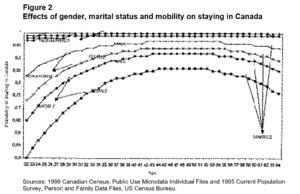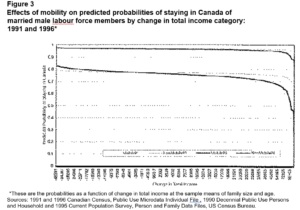
In earlier pieces, including one in the September 1999 issue of Policy Options, one of us (DeVoretz) has argued that in the 1990s the human capital transfer from Canada to the United States—more popularly known as the brain drain—was both real and costly. As we will argue in this article, a careful analysis of Canadian émigrés in the United States, both those who have moved permanently and, even more importantly, those who are in the United States on a temporary basis—indicates that the phenomenon persists.
In our view, this is not at all surprising. In fact, the more natural question, for an economist at least, is: Why haven’t even more highly-skilled Canadians moved to the US? Here we ask the corollary question: Why do so many highlyskilled Canadians stay in Canada? Many social commentators have recently grappled with variations of these questions, asking in effect: How much of the decision to stay in Canada depends on the social amenities the country offers? Prime Minister Jean Chrétien offers one answer to this question by citing the fact that Canada is ranked number one by the United Nations on its Human Development Index (HDI). This index presumably reflects a quality of life that is derived in part by the provision of the tax-financed public goods (health, education, and so on) which act as a magnet that holds some potential leavers.
But the attraction of these amenities is not unlimited. An economist would like to know just how much of an income gain would induce a highly-skilled Canadian to give up Canada’s social bundle of public goods and move to the United States. And whether the “staying power” or risk of movement by the highly trained changes as the potential mover’s age, gender or potential income gain changes. And whether being married, single or divorced affects potential migrants’ decision. In a much longer paper (RIIM Working Paper No. 00-06), we have addressed these and other questions. The purpose of this article is to present a summary of our findings and to begin exploring their possible policy implications.
The ease of obtaining a TN-1 visa cannot be overstated. With an employment letter and evidence of qualifications it can take as little as 15 minutes to be processed at the border. Though temporary, the TN-1, which was introduced as part of NAFTA, can be renewed indefinitely. In view of the greatly increased ease with which Canadians can get into the United States, it is hard to understand why a highly-skilled head of a household would stay in Canada, thus forgoing the 40 per cent rate of return available from investing in post-secondary education in Canada and then moving to the United States. To explain why, in the face of such a large economic temptation, the highly skilled might stay in Canada, it is necessary to appreciate the role of normal life-cycle events in constraining people’s movement. Education, marriage, divorce, previous moves, and the presence or not of children all affect the probability of staying in Canada. These events usually occur in a predictable sequence in a person’s life and they imply that the probability that a person will stay will first rise and then fall with age. If this (to us) reasonable presumption is borne out econometrically, it would have important policy implications.

Figure 1 shows what we regard as the normal life-cycle probability of a person’s staying in Canada. To motivate our empirical work, we assume that the typical highly-skilled Canadian enters the labour force unmarried at age 25, following a university career. At this stage of his or her life, there are few demographic constraints on mobility and, with several decades of employability ahead of the graduate, the lifetime income gain from moving to the US is at its maximum. Thus, the incentive to emigrate is at a maximum, and, conversely, the probability of staying in Canada is at a minimum. As the years pass, however, the cumulative income gain from emigrating to the United States declines: A shorter and shorter earning period remains. Thus, the probability of staying in Canada increases at a decreasing rate with age. Next, we argue that a peak interval is reached (age 45–55) when the probability of staying is essentially invariant to age: In these years, being an extra year younger or older is not likely to affect people’s decision to move.
But there is more to Figure 1 when we add the non-economic factors that influence mobility, including: marriage, the presence of children, previous movement, and divorce. These lifetime events further alter the probability of staying in Canada, and for two specific reasons. First, they raise (or lower) the cost of movement to the United States and thus deter (or encourage) movement. Second, access to Canadian publicly financed goods will increase as these changes in household status occur (that is, as more children are acquired or as a divorce takes place) and this in turn increases the probability of staying. Any one of these events can be uniquely captured by a shift in the probability of staying—for example, from (Pa-Pa) to (Pb-Pb) in Figure 1.
In sum, the probability of staying in Canada depends on the size of the income gain, which varies systematically with age, and on the onset of major lifetime events, which raises or lowers this probability. Both the shape of “the staying function” and the shifts in it that, we argue, different life-cycle events will cause will have important policy implications—if the model holds empirically, that is. We think it does and now proceed to provide the relevant evidence.
Does the empirical evidence support this modeling? Can we measure the affect of age and other demographic variables on the probability that a highly-skilled Canadian will stay in Canada? And can the value of Canada’s social amenities, which presumably are what keep Canadians here, also be estimated?
In the full version of this paper, we use Canadian census data for 1991 and 1996 and the 1990 and 1995 US Current Population Survey to estimate various “logit functions” before and after the NAFTA accord that allow us to answer the above questions. Figures 2 and 3 summarize our simulations.
Our econometric results, which are reported in detail in the working paper but not here, allow us to construct Figure 2, which shows the same relationship between the variables as Figure 1. For example, in 1996 for married males, the probability of staying in Canada is estimated to rise from .74 to .80 between the ages of 25 and 30. In other words, a young Canadian graduate has a probability of leaving of between 20 and 26 per cent in their youth, given the average qualities (in terms of marriage rates, income, and so on) of this recent cohort. The predicted effect of age is clearly confirmed as the probability of staying peaks at .88 during the age interval of 42 to 53 for the representative mid-life potential mover.
What if we control or isolate the potential mover to highlight the effect of different marital states or mobility experiences? The econometric results allow us to portray these effects in Figure 2. First, a prior move within Canada for both married males and females reduces the probability of staying in Canada by 8 to 20 per cent. For example, 35-year-old married males who have previously moved within Canada have a probability of staying in Canada of 0.85, while 35-yearold married males who haven’t had a previous move within Canada have a probability of staying of approximately 0.92.
Surprisingly, not being married actually reduces the likelihood that a person will leave Canada at some stage in his or her life. (People who aren’t married include those who are separated and divorced, with or without children, as well as people who have never married.) Married females with post-secondary degrees who had moved interprovincially in the previous five years had the lowest probability of staying in Canada (0.77 for 35-year-olds).
We argued earlier that, in addition to responding to these demographic variables, the probability of staying in Canada is sensitive to the income gain (or loss) from moving to the United States. Figure 3 depicts the effect of income gain on the probability of staying in Canada if they have or have not moved before within Canada (and are therefore “mobile” or “not mobile”). It does so for both 1991 and 1996.
The simulations behind Figure 3 clearly address the two central questions in the debate over staying in or leaving Canada: At what income gain will highly skilled Canadians leave, and what is the value of the social net that Canada provides? Some of its results are surprising.
First, for the representative highly-skilled male head of household the probability of staying is insensitive to income gains over a wide range. In other words, as the average potential annual income gain from moving to the United States increases from near zero (-$C662) to $C75,000 the chances that this kind of person will stay remain at 0.96 or greater. However, when a critical income gain occurs, greater than $75,000 in 1991, the probability of staying in Canada collapses. And this effect holds regardless of household status or previous moving experience.
The presumed effect of NAFTA and the easier mobility rules it brought between Canada and the United States are borne out by the results shown in Figure 3. The probability of staying drops 20 percentage points between 1991 and 1996 regardless of income gain or previous mobility status of the household. This decline is illustrated in Figure 2 by the parallel downward movement in the probabilities of staying in Canada circa 1996 (versus 1991) regardless of the head of household’s previous mobility experience. It should be emphasized that the only variables used to control for differences between 1991 and 1996 are the demographic ones mentioned here. Macroeconomic variables have not been used.
What have we learned from this analysis that we did not know from the extensive earlier work on the brain drain? First, Canadians’ “staying power” in the face of large prospective gains in income is extraordinary. In 1991, highly trained Canadians would forego $C75,000 in annual income gains before moving to the United States, in 1996 $C46,000. Thus, we now have an estimate of the implied value for the social goods and milieu provided by Canada. It is important to note that this “reservation wage” while large, is declining rapidly over time. It fell almost 40 per cent between 1991 and 1996. This combination of a declining critical income gain and the collapse in the probability of staying suggest that income was a more critical issue in affecting the brain drain in 1996 than 1991.
We have also learned that for highly-skilled households the motivation to stay in Canada is strong over a wide age range and across various household states (married, childless, and so on). In particular, after age 30 the probability of staying in Canada for a male-headed household exceeds 90 per cent until his retirement. What underlies this resistance to leave Canada?
One clue to this inertia is the role of the mobility variable used in this study. If you have moved within Canada in the last five years, this greatly reduces your probability of staying in Canada. Why? Presumably because interprovincial movement is associated with several other factors—acquiring higher education, fulfilling an initial job offer or possessing a greater taste for risk—which all lead to within-Canada movement. But once a successful internal move has occurred, most of the factors which would keep a potential émigré home no longer play an important part in the decision to make a more substantial move to the United States.
Our second major finding—that only a large gain in income will induce movement to the United States—also suggests that several conditions must all be in place to induce a move for a highly trained Canadian. In particular, the potential mover must be young, and expect a relatively rapid gain in earnings after arrival in the United States, conditions that in fact apply in particular to Canadian knowledge workers who typically receive payments in the form of stock options, to physicians entering their specialties and nurses or to star academics who receive a once-and-for-all large initial bonus upon movement. Thus, the income gain earned from movement to the United States does affect Canada’s ability to hold people. But the income gain earned must be large and immediate to cause movement.
What are the policy implications of these findings, assuming governments want to increase the probability that highly-skilled Canadians will stay in Canada? To offset the pull of the income gain from moving to the United States, two tactics should be explored. First, to be effective any income tax rebate to curtail leaving must be strategic in nature. It should target young, low-income but highly-skilled earners who are about to enter their high-income phase. This suggests a less steep marginal tax schedule for professionals, one that delays the onset of high rates to much higher levels of income. Moreover, professional income paid in kind (for example, stock options) which may yield a large gain in the future should be taxed less heavily or at least not be taxed until the gains are realized via disposition of the assets. On the other hand, our results suggest that once the income difference reaches the critical level, tax-based policy measures to stem the outflow are likely to be futile.
Second, any age-specific tax policy that aims at retaining the highly skilled should be phased out for those over age 40. The empirical evidence indicates that once the highly skilled have stayed to age 40 they are very likely to continue on in Canada. Similarly, private-sector measures such as internships and more aggressive wage bidding at the entry level (age 25-38) should aim to hold the highly skilled until the aging process raises the probability of their staying.
What about measures to induce Canadian residents to return to Canada and reacquaint themselves with Canada’s evidently considerable attractions? If we look to successful examples of repatriation of the highly skilled in countries such as India, Ireland or Taiwan, one common feature appears. These countries all had a substantial and dynamic high-technology sector to induce these skilled people to return. In this regard, the recent difficulties of companies such as Nortel and JDI Uniphase are not encouraging. Still, Canadian history offers another tactic consistent with the findings reported. In the late 1960s, after a decade of the brain drain to the United States, Canada induced Canadian academics to return with a combination of attractive career opportunities and three years of federal income tax forgiveness. This is a prime example of an age-strategic income incentive that would probably also work in the 21st century. The wisdom of this policy is threefold. First, the small foregone income tax can easily be recouped if a fraction of the repatriated Canadians remain in Canada. Second, the remission is only for three years, in many cases just enough time for the representative returning Canadian to age and establish roots in the community. And, third, repatriating Canadians would be less costly than importing highly skilled replacements from the rest of the world.
In the end, however, the brain drain that is causing the departure of many of Canada’s high-income earners remains a by-product, not mainly of Canadian conditions, but of the state of the US economy and the immigration policies of the US Government. Changes in either have the potential of slowing the southward movement faster than any Canadian policies could. The rules of NAFTA preclude the United States from halting the movement of Canadians to the United States, but the coming United States recession may slow it down.
The longer version of this paper is available at www.riim.metropolis.net.
Photo: Shutterstock









